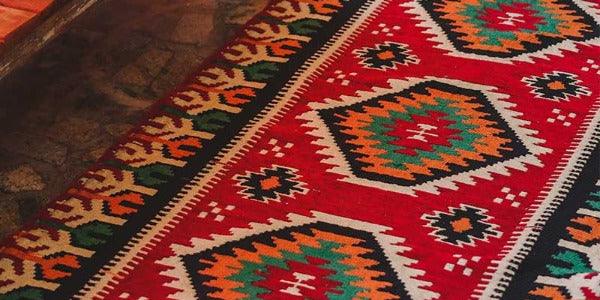If you go through the pages of ancient history recorded in literary narratives with a mythological and historical bias through ancient authors such as Homer and contemporary authors such as Alastair Hull , respectively, you will realize that the female voices silenced over the centuries found in looms a powerful means of communication to express history, customs and yearnings from their woven points of view and with their own hands and symbolism.
In this way, the distinctive patterns of traditional tapestries such as the Kilim reveal not only immeasurable cultural and material values in addition to the unique beauty that transforms interior decoration with its color combinations, but also display the essence of oriental art that comprises countries such as Turkey ( Anatolia ), Iran ( Saandaj ), Egypt ( Fuwa ), among others.

Carpet weaving was one of the main forms of female communication in history.
Kilim , Klim or Kelim are Turkish words of Persian influence that define flat weaving tapestries made with the interweaving of wefts and wool warps on a vertical loom ( flatweaving ), without knots, creating bold geometric motifs , whose symbols are exceptional ethnic differentiators and are part of of the cultural heritage of regions such as the Middle East, Balkans, Caucasus, North Africa, Central Asia, South Asia and the Far East.
The most traditional technique for weaving the Kilim carpet is the slitweave , which consists of looping the thread by weaving it and securing it with the comb ( beating comb ) between the gaps in the warp (longitudinal threads) which is placed vertically on the loom to form exclusive textiles with designs in different color blocks. These ethnic patterns are estimated to have Mesopotamian origins, dating between 8000 BC and 4000 BC.

Kilim symbolizes handmade tapestry with knotless loops between the gaps in the warps.
Kilim iconography is shown in living room rugs and runners , keeping alive the language that weavers from different nomadic peoples used to materialize the culture of the ethnic group they belonged to. These memories woven in vibrant colors forming complex decorations on the tapestries reveal how oriental weaving sustained authenticity by safeguarding the traditional techniques of spinning, dyeing and weaving the threads.
The excellent artistic quality of the work of Egyptian weavers is another trait that the Kilim identity was preserved and their designs stamping handcrafted rugs transmitted from generation to generation. The current weaving of ethnic rugs by small craftsmen is also a symbol of the resistance of tradition to Chinese industrial production.

The patterns of Kilim rugs exalt the identity of different nomadic ethnic groups.
Each drawing reproduced along the rug presents a particular symbolism that refers to the customs, feelings and understanding of the world of ancestral peoples . Initially, Kilim symbols were used to inform and transmit stories, however, with the mixture of cultures and ethnicities , the mythical sphere and shamanic cosmology were incorporated, making the cultural value intertwined in each pattern of the rugs not limiting them to the decorative purpose.
Some motifs are frequently revisited, such as: Kocboynuzu (ram's horn), symbol of power and masculinity; Bukagi ( fetter or cuff) showing family unity; Elibelinde (hands on hips), representing fertility and femininity; Sacbagi (headband), representing the female desire to marry; Bereket ( Elibelinde + Kocboynuzu ) inspiring fertility and protection of the home; Kurt Agzi (Wolf's Mouth); symbolizing the desire for solidarity; between others.

Kilim symbols are works of art from Egyptian tapestries that elegantly cover the floor.
In each Kilim there is a set of these ancient symbols that tell their own stories woven by the weavers of Egypt who generously share the tradition of tapestry with the world of decoration . The predominant color (blue, black, red or wine), in turn, acts as a background highlighting the patterns to promote a special tone in the environments.
The inspiring essence of the motifs and the handcrafted work enhance the piece by taking it from the status of a utilitarian object to elevate it to that of an empowering work of art . In it, the female voice, so often silenced, is not swept “under the rug ”, but stamps it with enriching aesthetics and purposes, expressing from the desire to marry with earrings ( Kupe ) to mystical symbols of protection and abundance such as the burdock plant ( Pitrak ).

The predominant color of the Kilim rug gives a special tone to the decor with an ethnic essence.
The unique style of the Kilims in our online store makes them versatile pieces for different types of decor. They can be used as blankets on sofas and on the edge of beds, expanding the feeling of coziness; in wall decoration to create a focal point in interiors or on the floor as powerful affirmations guiding the steps within the environment. When choosing a rug to call your own, rely on your sense of style and what the designs evoke in you.
Namaste!
Milene Sousa - Art & Tune










